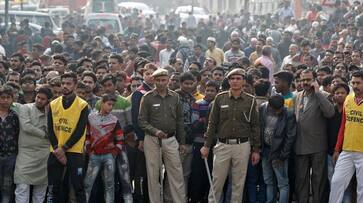The recent fire incident in an illegal factory in north Delhi, which claimed 43 innocent lives leaving sixteen injured, is a textbook example of how illegal factories with no fire safety norms, underdeveloped, crammed areas, with no adequate infrastructure continue to exist as authorities pay no value to the existence of common men
Bengaluru: Fire tenders were rushing to the same building in Anaj Mandi were the fire broke out yet again. A fire incident in an illegal factory in north Delhi has claimed 43 innocent lives and has left over sixteen injured. It is now being termed as the second worst fire incident that Delhi has ever witnessed. It took over 150 firefighters with 50 fire engines and almost four hours to douse the blaze. The officials have claimed that they have often received calls for fire from this area. However, they haven’t taken any action in this regard despite illegal factories operating in this area, some of which are hardly 200 meters from this building. These areas have always disregarded all fire and municipal safety norms. This area is a textbook example of illegal factories and manufacturing units operating out of old buildings in city which are usually inhabited by the lower strata of our society, of which our politicians seldom care. The life of a common man in India has no value. It has been proved time and again. Our disaster management system is in shambles.
As our cities are expanding to accommodate the rising urban migration, we often forget the safety measures necessary to support this growing urbanisation. As we expand the cities, we often tend to forget the urbanisation of the old spaces in these cities. Many factories and small manufacturing units are often located in old, cramped quarters of the cities, where the cost of land is relatively cheaper. Workers stay there to save money on rent. There have been no measures undertaken by authorities to build affordable housing for the labourers. These are the places where the population agglomerations are dense and have often been ignored with respect to investments in equipment or infrastructure to guarantee their safety. There have been nine major fire incidents in Delhi from January 2018, and most have been in areas which are crammed up or have illegal factories with people who have negligible understanding of fire safety.
Most of the fire tragedies in India happen at places where it is difficult to get rescue teams and ambulances. Urban planning needs to incorporate disaster management. Urban development is the most ignored area in India as votes come from rural areas. Accountability is a serious question mark in such tragedies. So many inquiry commissions are set up after such incidents, but either we never get the reports, or even if we get one there is no accountability traced. Hence it is difficult to punish the responsible people.
According to a study sponsored by the ministry of home affairs, at least 8599 fire stations are required in India, but we only have 2087 which are functioning. India also requires an additional 559,681 trained individuals in firefighting, 221,411 firefighting equipment, and 9,337 firefighting vehicles and units. This lack of basic infrastructure has led to countless loss of lives already in just accidental fires. As the population of India is increasing at a steady pace, we can only expect such incidents to increase unless we start changing and investing in the safety of our own people today.
It is estimated that by 2050, almost 70% of the global population will be living in cities. If this tragedy doesn’t force us to understand the importance of safety in our crammed-up cities, we are definitely walking towards a deadly inferno.
About Abhinav Khare
Abhinav Khare is the CEO of Asianet News Network and also the host of a daily show named Deep Dive with AK. He has a lifetime collection of books and gadgets and has already pinged more than hundred cities around the globe.
He is a tech entrepreneur, who is passionate about policy, technology, economy and philosophy from ancient India. He earned an MS Engineering from the ETH Zurich and an MBA Finance from the London Business School.
Last Updated Dec 10, 2019, 7:16 PM IST









![Salman Khan sets stage on fire for Anant Ambani, Radhika Merchant pre-wedding festivities [WATCH] ATG](https://static-gi.asianetnews.com/images/01hr1hh8y86gvb4kbqgnyhc0w0/whatsapp-image-2024-03-03-at-12-24-37-pm_100x60xt.jpg)
![Pregnant Deepika Padukone dances with Ranveer Singh at Anant Ambani, Radhika Merchant pre-wedding bash [WATCH] ATG](https://static-gi.asianetnews.com/images/01hr1ffyd3nzqzgm6ba0k87vr8/whatsapp-image-2024-03-03-at-11-45-35-am_100x60xt.jpg)


